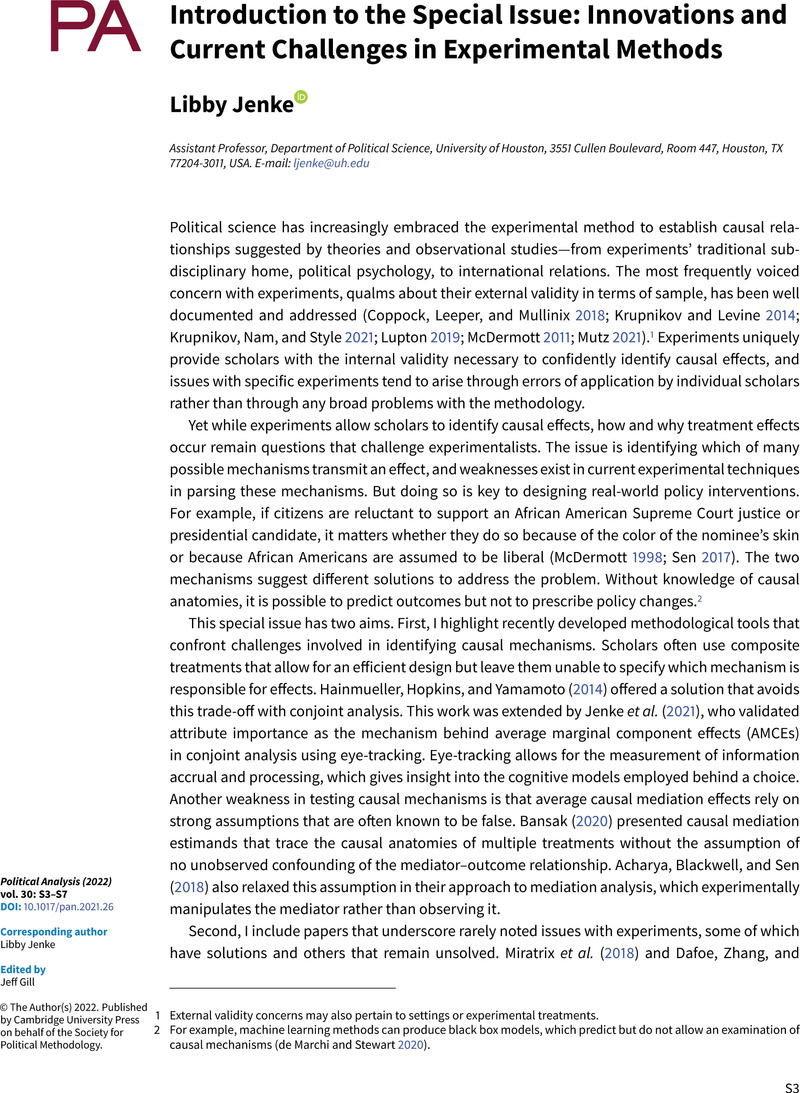No CrossRef data available.
Article contents
Introduction to the Special Issue: Innovations and Current Challenges in Experimental Methods
Published online by Cambridge University Press: 14 January 2022
Abstract
An abstract is not available for this content so a preview has been provided. Please use the Get access link above for information on how to access this content.

- Type
- Introduction
- Information
- Political Analysis , Volume 30 , Issue S1: Virtual Special Issue: Innovations and Current Challenges in Experimental Methods , January 2022 , pp. S3 - S7
- Copyright
- © The Author(s) 2022. Published by Cambridge University Press on behalf of the Society for Political Methodology
Footnotes
Edited by Jeff Gill
References
Acharya, A., Blackwell, M., and Sen, M.. 2018. “Analyzing Causal Mechanisms in Survey Experiments.” Political Analysis 26(4):357–378.CrossRefGoogle Scholar
Bansak, K. 2020. “Comparative Causal Mediation and Relaxing the Assumption of No Mediator–Outcome Confounding: An Application to International Law and Audience Costs.” Political Analysis 28(2):222–243.CrossRefGoogle Scholar
Bansak, K., Hainmueller, J., Hopkins, D. J., and Yamamoto, T.. 2021. “Conjoint Survey Experiments.” In Advances in Experimental Political Science, edited by Druckman, J. N. and Green, D. P., 19–41. Cambridge: Cambridge University Press.Google Scholar
Chan, A.-W., and Altman, D. G.. 2005. “Identifying Outcome Reporting Bias in Randomised Trials on PubMed: Review of Publications and Survey of Authors.” BMJ 330(7494):753.CrossRefGoogle ScholarPubMed
Chan, A.-W., Hróbjartsson, A., Haahr, M. T., Gøtzsche, P. C., and Altman, D. G.. 2004. “Empirical Evidence for Selective Reporting of Outcomes in Randomized Trials: Comparison of Protocols to Published Articles.” JAMA 291(20):2457–2465.CrossRefGoogle ScholarPubMed
Chong, D., and Druckman, J. N.. 2010. “Dynamic Public Opinion: Communication Effects over Time.” American Political Science Review 104(4):663–680.CrossRefGoogle Scholar
Coppock, A., Leeper, T. J., and Mullinix, K. J.. 2018. “Generalizability of Heterogeneous Treatment Effect Estimates Across Samples.” Proceedings of the National Academy of Sciences 115(49):12441–12446.CrossRefGoogle ScholarPubMed
Dafoe, A., Zhang, B., and Caughey, D.. 2018. “Information Equivalence in Survey Experiments.” Political Analysis 26(4):399–416.CrossRefGoogle Scholar
de Marchi, S., and Stewart, B.. 2020. “Wrestling with Complexity in Computational Social Science: Theory, Estimation and Representation.” In The SAGE Handbook of Research Methods in Political Science and International Relations, edited by Curini, L. and Franzese, R., Vol. 2, 289–310. Washington, DC: Sage.CrossRefGoogle Scholar
Franco, A., Malhotra, N., and Simonovits, G.. 2015. “Underreporting in Political Science Survey Experiments: Comparing Questionnaires to Published Results.” Political Analysis 23(2):306–312.CrossRefGoogle Scholar
Franco, A., Malhotra, N., Simonovits, G., and Zigerell, L.. 2017. “Developing Standards for Post-Hoc Weighting in Population-Based Survey Experiments.” Journal of Experimental Political Science 4(2):161–172.CrossRefGoogle Scholar
Gaines, B. J., Kuklinski, J. H., and Quirk, P. J.. 2007. “The Logic of the Survey Experiment Reexamined.” Political Analysis 15(1):1–20.CrossRefGoogle Scholar
Gerber, A. S., Gimpel, J. G., Green, D. P., and Shaw, D. R.. 2011. “How Large and Long-Lasting Are the Persuasive Effects of Televised Campaign Ads? Results from a Randomized Field Experiment.” American Political Science Review 105(1):135–150.CrossRefGoogle Scholar
Gerber, A. S., et al. 2014. “Reporting Guidelines for Experimental Research: A Report from the Experimental Research Section Standards Committee.” Journal of Experimental Political Science 1(1):81–98.CrossRefGoogle Scholar
Hainmueller, J., Hopkins, D. J., and Yamamoto, T.. 2014. “Causal Inference in Conjoint Analysis: Understanding Multidimensional Choices via Stated Preference Experiments.” Political Analysis 22(1):1–30.CrossRefGoogle Scholar
Imai, K., Keele, L., Tingley, D., and Yamamoto, T.. 2011. “Unpacking the Black Box of Causality: Learning About Causal Mechanisms from Experimental and Observational Studies.” American Political Science Review 105(4):765–789.CrossRefGoogle Scholar
Jenke, L., Bansak, K., Hainmueller, J., and Hangartner, D.. 2021. “Using Eye-Tracking to Understand Decision-Making in Conjoint Experiments.” Political Analysis 29(1):75–101.CrossRefGoogle Scholar
Kalla, J. L., and Broockman, D. E.. 2018. “The Minimal Persuasive Effects of Campaign Contact in General Elections: Evidence from 49 Field Experiments.” American Political Science Review 112(1):148–166.CrossRefGoogle Scholar
Krupnikov, Y., and Levine, A. S.. 2014. “Cross-Sample Comparisons and External Validity.” Journal of Experimental Political Science 1(1):59–80.CrossRefGoogle Scholar
Krupnikov, Y., Nam, H. H., and Style, H.. 2021. “Convenience Samples in Political Science Experiments.” In Advances in Experimental Political Science, edited by Druckman, J., and Green, D., 165–183. Cambridge: Cambridge University Press.CrossRefGoogle Scholar
Levendusky, M. S. 2013. “Why Do Partisan Media Polarize Viewers?” American Journal of Political Science 57(3):611–623.CrossRefGoogle Scholar
Lupton, D. L. 2019. “The External Validity of College Student Subject Pools in Experimental Research: A Cross-Sample Comparison of Treatment Effect Heterogeneity.” Political Analysis 27(1):90–97.CrossRefGoogle Scholar
McDermott, M. L. 1998. “Race and Gender Cues in Low-Information Elections.” Political Research Quarterly 51(4):895–918.CrossRefGoogle Scholar
McDermott, R. 2011. “Internal and External Validity.” In Cambridge Handbook of Experimental Political Science, edited by Druckman, J., Greene, D., Kuklinski, J., and Lupia, A., 27–40. Cambridge: Cambridge University Press.CrossRefGoogle Scholar
Miratrix, L. W., Sekhon, J. S., Theodoridis, A. G., and Campos, L. F.. 2018. “Worth Weighting? How to Think About and Use Weights in Survey Experiments.” Political Analysis 26(3):275–291.CrossRefGoogle Scholar
Mutz, D. C. 2021. “Improving Experimental Treatments in Political Science.” In Advances in Experimental Political Science, edited by Druckman, J., and Green, D., 219–238. Cambridge: Cambridge University Press.CrossRefGoogle Scholar
Semmelmann, K., and Weigelt, S.. 2018. “Online Webcam-Based Eye Tracking in Cognitive Science: A First Look.” Behavior Research Methods 50(2):451–465.CrossRefGoogle ScholarPubMed
Sen, M. 2017. “How Political Signals Affect Public Support for Judicial Nominations: Evidence from a Conjoint Experiment.” Political Research Quarterly 70(2):374–393.CrossRefGoogle Scholar
Xu, P., Ehinger, K. A., Zhang, Y., Finkelstein, A., Kulkarni, S. R., and Xiao, J.. 2015. “TurkerGaze: Crowdsourcing Saliency with Webcam Based Eye Tracking.” Preprint, 2015, arXiv:1504.06755.Google Scholar
Yang, X., and Krajbich, I.. 2020. “Webcam-Based Online Eye-Tracking for Behavioral Research.” doi:10.31234/osf.io/qhme6.CrossRefGoogle Scholar




